Dashboard Baking: I Tried TikTok Trend of Baking Cake in My Car
Joe Brown once spent 20 minutes cleaning gummy pizza off his dashboard. Such a small price for glory.
A few years before that gummy pizza video tallied 31 million views, 20-year-old Brown was working in a movie theater and had a fun TikTok habit with 10,000 followers. After the theater closed with the COVID lockdown, he decided to try to cook an egg on the hot sidewalk in front of his Gilbert, Arizona house for entertainment purposes. It came out surprisingly well and earned him a few thousand more followers. Soon, he was planning an outdoor cooking series. At first, his family and friends didn’t pay much attention, but soon they started offering ideas and challenges, and his girlfriend Kay even helps out these days. He moved on to rooftop grilling, and then started cooking in his hot car last year. He’s done cupcakes, pizza, grilled cheese, pasta, chicken nuggets and potatoes, just to name a few.
And he doesn’t just cook, he also melts for comedic effect — candles, crayons, taffy. My personal favorite video documents a tray of gummy bears left on his roof. Within an hour, they melted into a sinister pool of goo, slid out of the pan and onto his roof tiles, and then hung in disturbing icicles before puddling on the driveway below. I feel just a tad guilty because he burned his mouth on them to make the video, but I laughed really hard.
I live in Texas where it’s almost as hot, and this year’s June temperatures are already August-worthy, so I cannot wait to try this myself. Let’s figure out the method to this madness.
Brown’s best results (at least in terms of edibility, if not hilarity) come when he uses metal and foil-lined pans. Things are naturally angled on the roof, and if he’s using the car, he tilts the pan toward the windshield a bit. He says he usually looks for temperature readings over 200 F to start the cooking process, which often takes about three hours.
Before we go any further, let’s talk about mishaps. Brown has gotten a bit singed more than once and recommends oven mitts for any rooftop or car cooking. You also need to let things cool a bit before you pop them in your mouth — they’re going to be hot just like they would be after coming out of your indoor oven. At least, that’s the best-case scenario. Cooking at relatively low temperatures for long periods of time opens you up to foodborne illness. Brown has made some things that I think are firmly in do-not-try-this-at-home territory, like bacon, steak and cookie dough containing eggs. Sometimes he’s had to throw things out. Food held at temperatures between about 40 and 140 F for longer than two hours are more likely to harbor bacteria that can make you sick, really sick. Brown himself had a trip to urgent care after his rooftop pancakes turned out "rancid." And while we’re on the topic of rooftops, how much bird poop do you think is on yours? Still want to put a baking pan up there?
Dashboard it is!
Given the potential hazards, I’ve chosen a food that’s low risk for bacterial growth — an old recipe from the Great Depression, when eggs and milk were in shorter supply, called wacky cake. It contains just flour, sugar, cocoa, oil, salt, a little vinegar and baking powder, nothing that would easily become unsafe. To that, you add warm coffee or water to make the batter, and that means that the cake gets a little bit of a head start in heating. I’m also going to monitor the temperature throughout with a probe thermometer, so that if it ends up below 140 F for longer than a couple of hours, I will know to chuck it for safety’s sake.
Another plus for this recipe is the beautiful cocoa color, because browning requires the Maillard reaction, a constellation of chemical reactions so complicated that it hasn’t even been described in detail in scientific terms. Just know that it requires protein, sugar and heat to occur, and if you are trying to get it done in less than 12 hours, it’s going to take at least 300 F, which we aren’t going to achieve on the dashboard. That’s why recipes like Brown’s pancakes and grilled cheese are so pale.
The last thing to consider is that this kind of cake does best if it bakes quickly after mixing, so that there are enough bubbles remaining from the vinegar’s reaction with the baking soda to keep it light. I’m afraid the cake won’t bake fast enough in the car, resulting in a dense crumb, but I’m hoping the aforementioned pros outweigh the cons.
On baking day, my dashboard was 176 F by noon and it was forecast to get hotter, so I put the foil-covered tray and a parchment-lined metal springform pan on the dashboard to preheat.
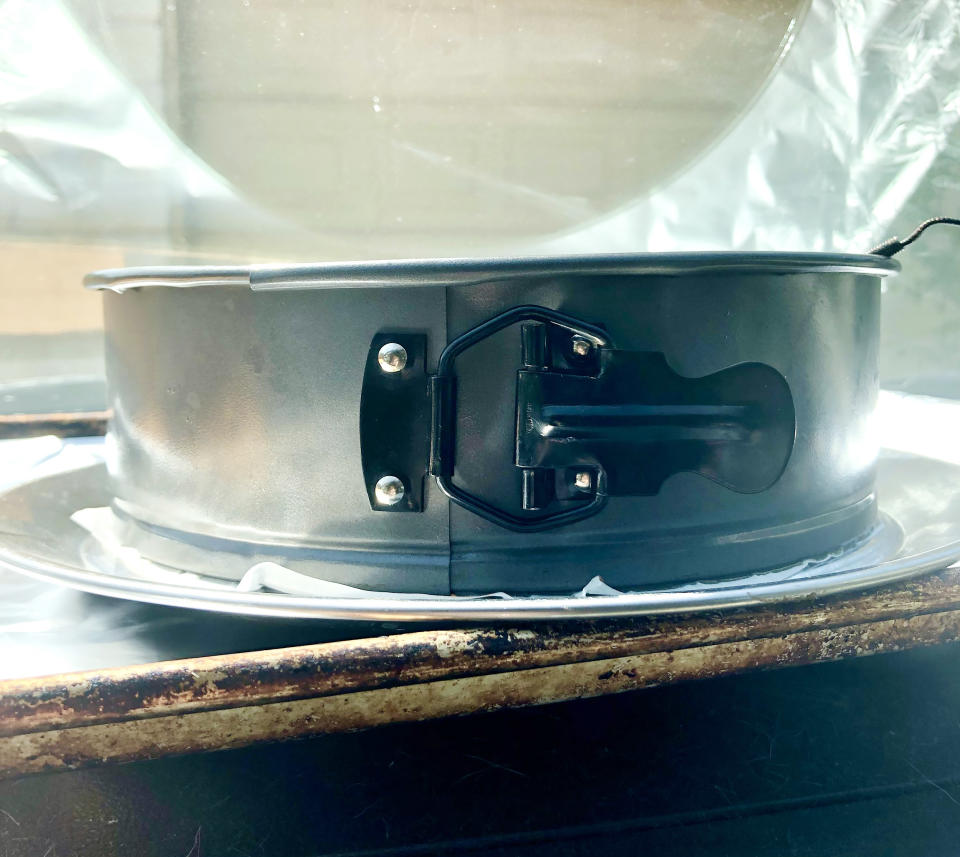
I made a mental note to let the neighbors know what I was doing so that they didn’t think I’d gone around the bend, which I promptly forgot to do. (They’re probably organizing a Neighborhood Watch as I write.) After about 45 minutes, I mixed up my batter inside. As you can see, it bubbles up immediately, so time is of the essence.
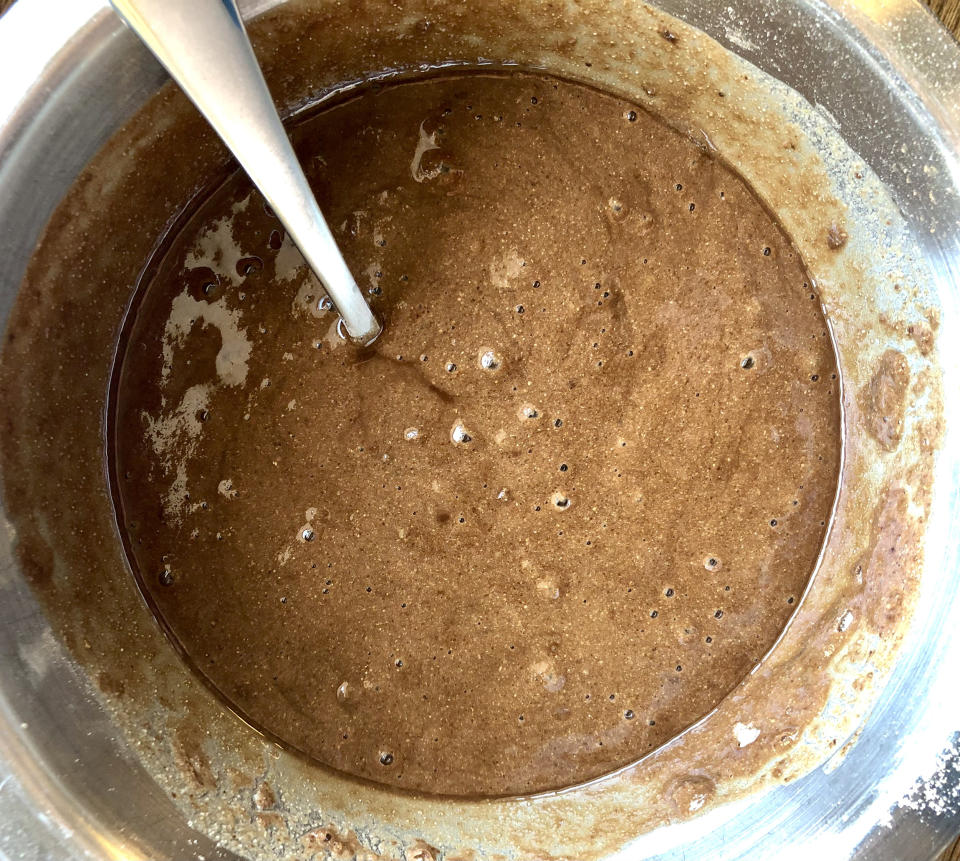
I didn’t want the pan to cool off by bringing it into the AC, so I ran out there with a spoon and an oven mitt on a tray, threw open the door, got in and closed it again as quickly as possible to retain as much heat as I could. I then poured the batter into the pan whilst sitting in my oven. This was not easy to do. I had a thick tea towel on my lap to keep the pan from burning me, but it was difficult to coordinate all this in cramped quarters. I was pretty smug about thinking to bring everything out on a tray — otherwise, I wouldn’t have had anywhere to put that batter-covered spoon while I secured the baking pan. No one wants cake batter on their car seats!
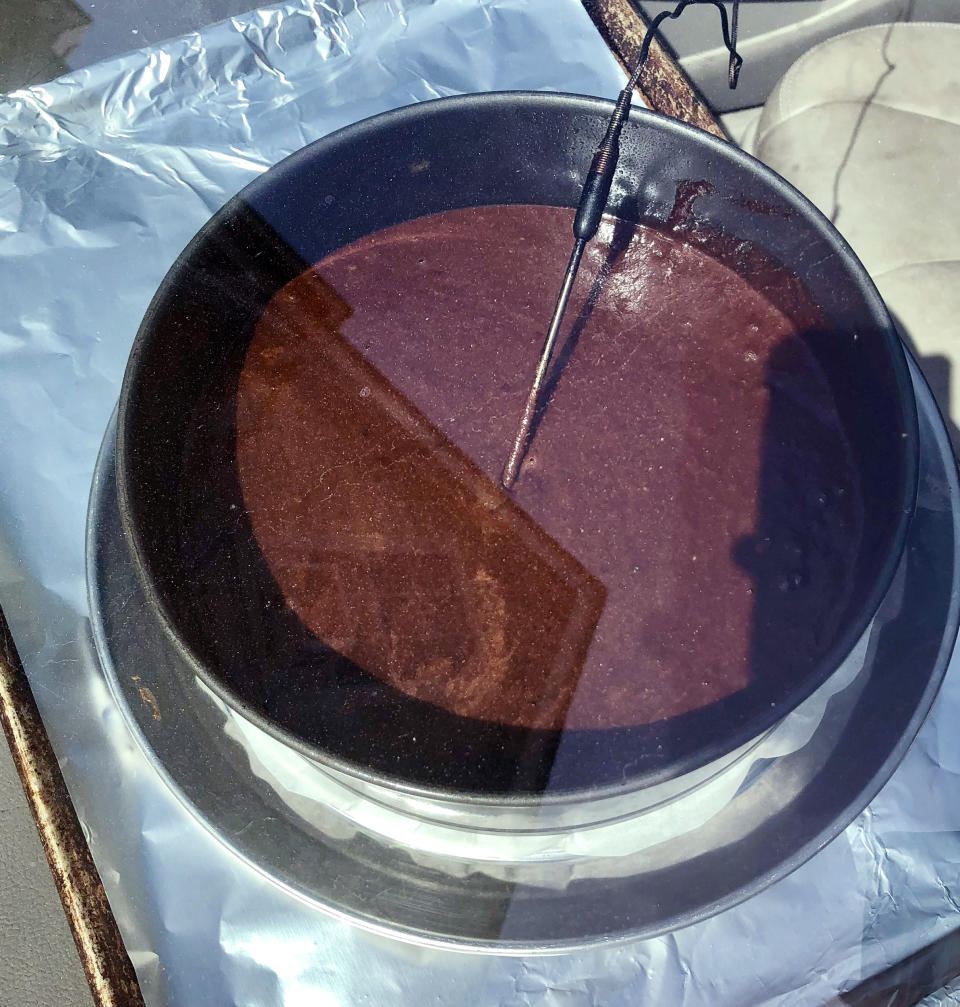
I set the probe thermometer in the pan, and went inside to wait. Yummy cake was just two or three, maybe three-and-a-half hours away! I decided to check after an hour for documentation purposes.
Experiment 1, hour 1: This happened.

I’m not so smug now, am I? I took this as proof of concept, though, because it was definitely partially baked onto the seat. As bad as it was, it could have been so much worse. I somehow lucked out when the whole apparatus slid off the dashboard, because the springform pan flipped upside down onto the sheet pan. Other than the relatively manageable puddle on the seat, there were only a couple of spots of batter, and everything else was contained in the pans.
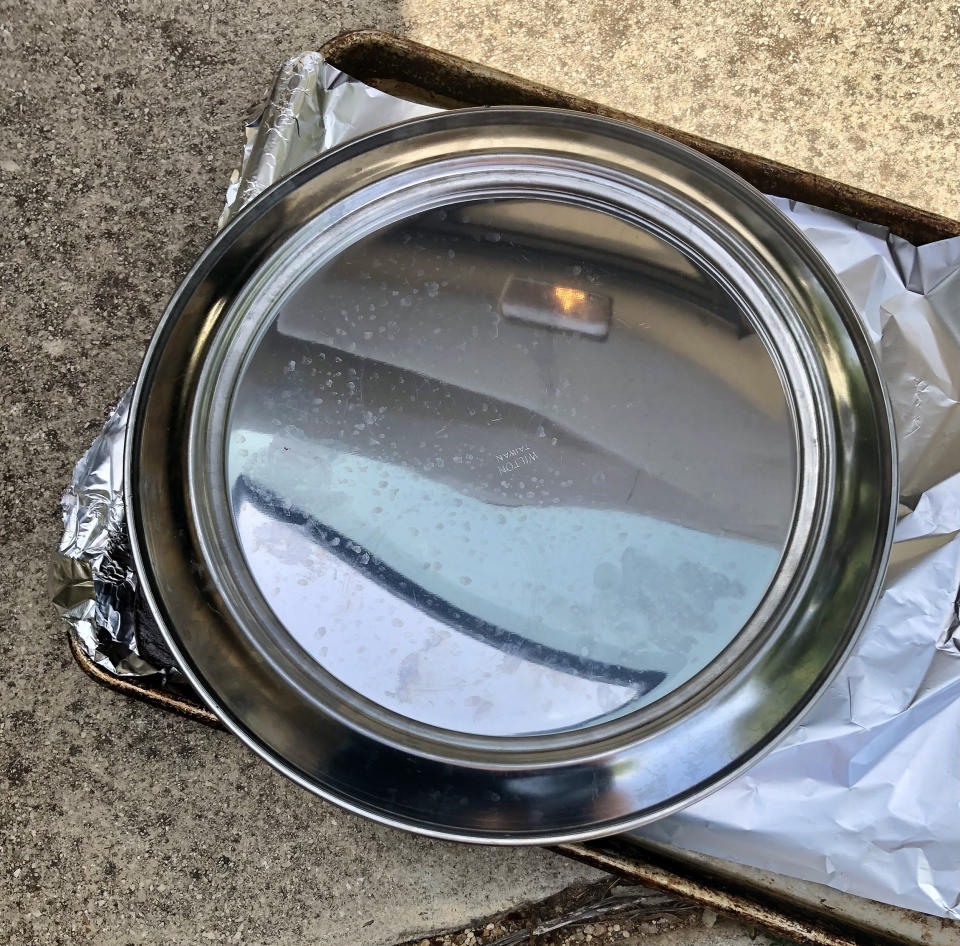
For my second attempt, I decided to use a mini muffin tin. I put the pans in the sun on the dashboard to preheat, carefully wedging them to avoid another disaster, and after only 45 minutes, it was 185 F. I mixed up half a recipe of wacky cake batter this time, filled each one 2/3 full in case they did actually rise, and shut the door.
Experiment 2, hour 1:
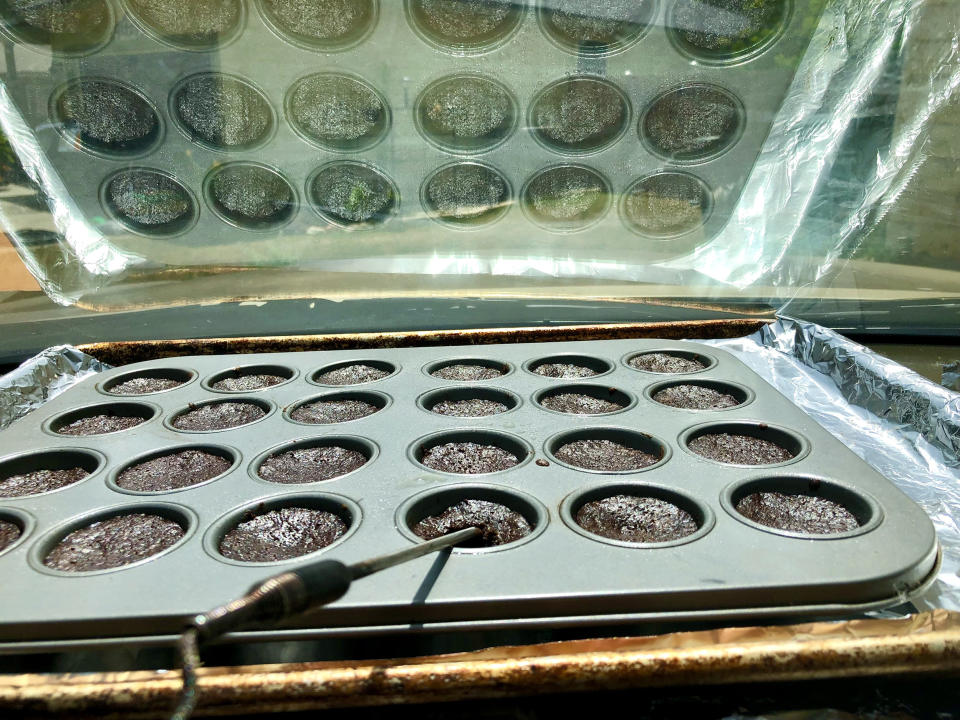
They were definitely cooking, but didn’t spring back when pressed. It seemed like they were baking from the top down, like a giant Easy Bake Oven with the massive light bulb 93 million miles away. I was pretty sure the bottom was still unbaked, so I closed the door again.
Hour 2:
They were hot as blazes and dry to the touch. Cake usually needs to have an internal temperature of around 200 F to call it done. I gave them another 15 minutes, but mine never got above 193 while I was looking.
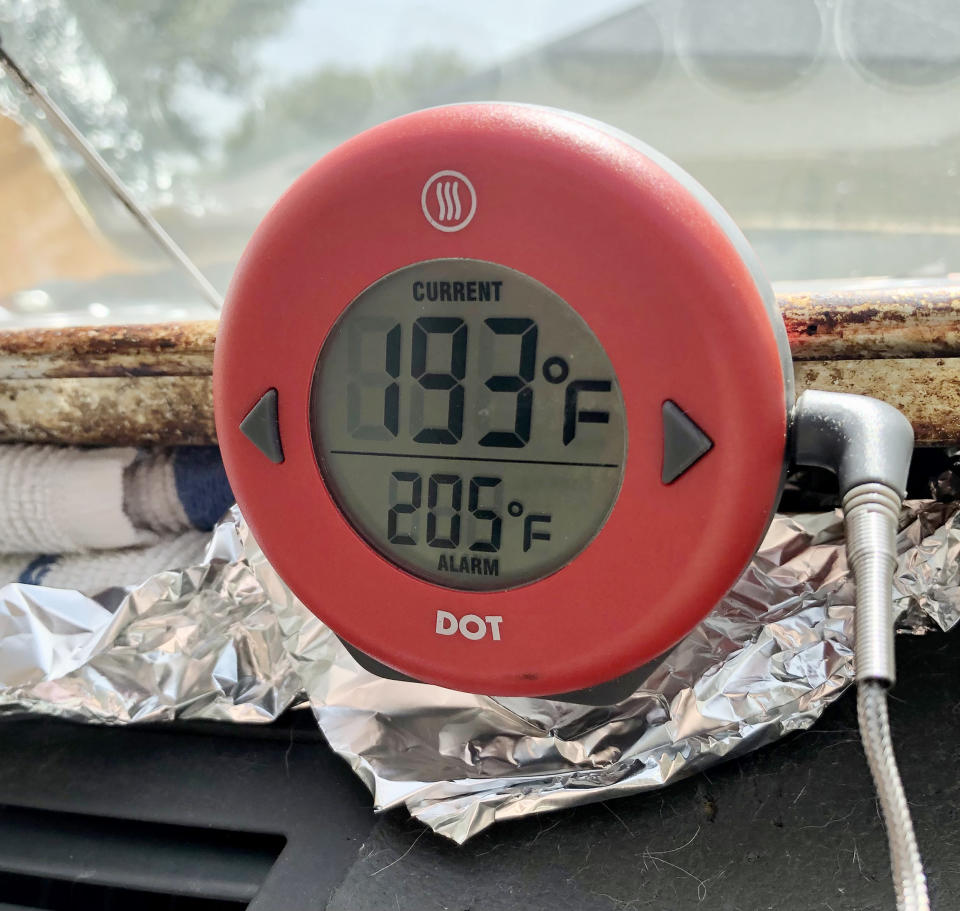
I hoped that maybe their mini size and egg-less batter would mean that was enough. They were sunken in the middle, but they still had some bounce. It was better than I had hoped, although since the top cooked first, the edges were crunchy.
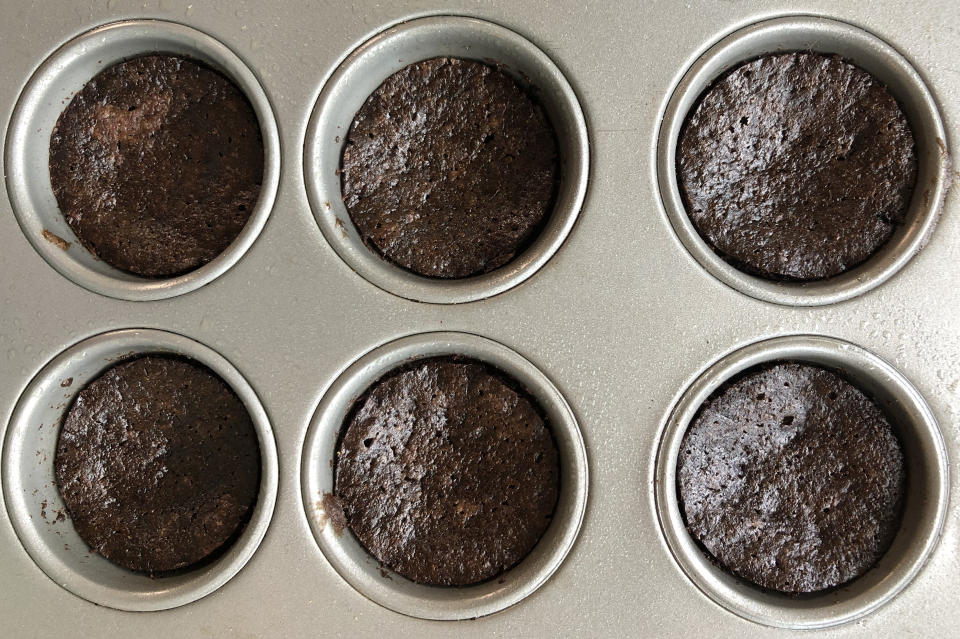
You have to let cake cool a bit before taking it out of the pan, or it will stick and tear. I let these cool for about 15 minutes, and they were pulled away from the edge of the pan, so I loosened a couple with a wooden knife and popped them out.

Cake crumbs are great for cake pops. Those are in, right? And cake bits go into trifle, too, which is oh so de rigueur what with the Queen’s Jubilee. But, I still l had hope for a more photogenic outcome and decided to let them cool, covered so they didn’t dry out even more, until they were stone cold, the way Mary Berry used to say on "The Great British Bake Off." It still took some careful nudging, but they finally came out in one piece.
Not bad, right?
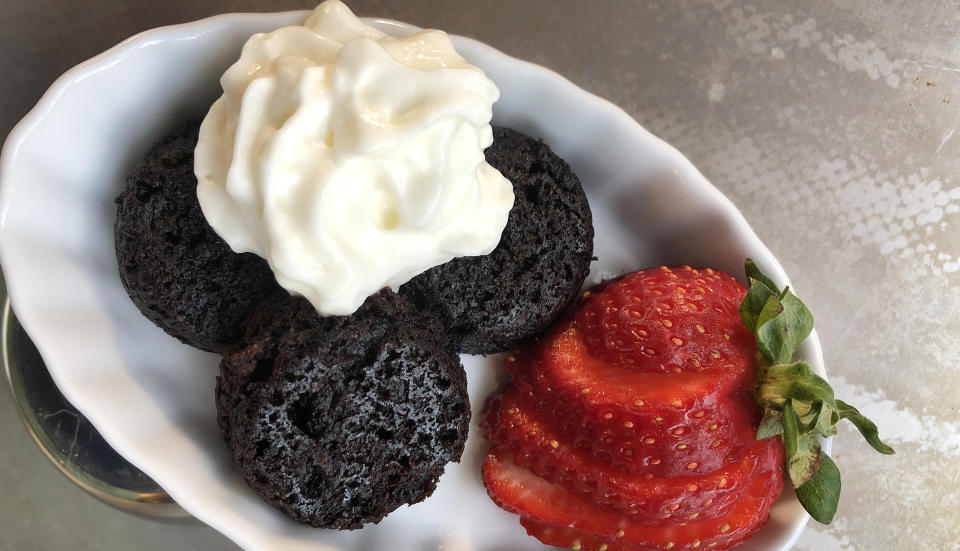
The top surface is definitely dry and the crumb is dense, more like brownie pucks than cake, so let’s just pretend that’s what we were trying to make!
So, do I want you to try turning your car into a giant Easy Bake Oven yourself? Well, I do want to encourage you to experiment. And I do want you to find ways to use clean energy. When I asked Brown whether he does any other cooking, he said, "The short answer is no," he laughed, "But I am trying to learn." That’s what I hope people take away from his TikTok. Whether it’s on your dashboard or not, be open-minded and curious. Have fun. And most importantly, for pity’s sake, read the FDA handout on food safety so you’ll know how to use a kitchen thermometer to make sure the internal temperature of what you plan to eat has reached the safe mark.
As for the clean energy part, it’s easier to control food safety if you aim to use less energy but not necessarily none. I have one of these very cool Wonderbags, which keep a heavy pot of beans or stew at a high temperature for hours, sort of like a passive slow cooker. The only energy you use is a few minutes of stovetop boiling. You can also choose other methods of quick cooking, like stir-fry or batch cooking and freezing for later. And every dietitian’s favorite low-energy-use eating tip is snacking on fresh fruits and vegetables.
What’s next for Brown? When we caught up to him, he was working on toasting some Eggo waffles in his car. He’s got merch coming — T-shirts with his hilarious "10/10, would recommend" catchphrase along with an Arizona logo. He’s also looking to see whether he could do something to help others with his notoriety, like PSAs on keeping pets and vulnerable humans out of stifling cars. After all, nobody knows how hot it can get in there better than Joe Brown.

